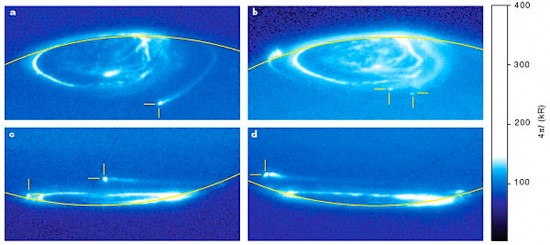
Three of Jupiter’s moons leave their “footprints” in Jupiter’s auroral oval. Credit: J. T. Clarke, J. Ajello, G. Ballester, L. Ben Jaffel, J. Connerney, J.-C. Gérard, G. R. Gladstone, D. Grodent, W. Pryor, J. Trauger and J. H. Waite, Jr. “Nature” 415, 997-1000 (28 February 2002)
Apr 27, 2015
Earth and Jupiter reveal their common connections to the Sun.
As previous Picture of the Day articles mention, Earth possesses a complex electrically active structure called a magnetotail (or plasma tail) that extends for millions of kilometers, always pointed away from the Sun. Streams of charged particles ejected from the Sun, conventionally called the solar wind, are captured by our planet’s magnetosphere, and along with ions generated by Earth itself, collect in a plasma sheet within the magnetotail, where they are held together by Earth’s magnetic field.
Solar ions follow Earth’s magnetic field down into the poles, causing atmospheric molecules to emit light: red from oxygen at high altitudes, then green from oxygen lower down, along with blue from nitrogen. The wind-wavering veils of color have both puzzled and entranced observers for countless millennia. In 1621, Pierre Gassendi called the shimmering curtains of light seen in the Arctic the Aurora Borealis after Aurora, the Roman goddess of dawn, and Boreas, the Greek name for the north wind.
There are also aurorae on Jupiter. However, Jupiter’s auroral light shows are not transient like those on Earth, which are activated by intense solar flare outbursts from the Sun, they are continuously active. The auroral structure is complex, and does not depend entirely on interactions with solar wind plasma. As on Earth, there are sudden energy releases in Jupiter’s aurorae.
In 1903, Kristian Birkeland’s Arctic expedition discovered that electricity from the Aurora Borealis flowed parallel to the auroral formation. Since electric charge must move in a circuit, and since the auroral glow seemed to be caused by events in space, he proposed that the charge flow was down from space at one end of the auroral arc and back out to space at the other.
In 1973, a magnetometer aboard the U.S. Navy satellite Triad found two gigantic plasma sheets carrying a million amperes or more. One plasma sheet descended from the aurora’s morning side and the other ascended from the evening side. Since Birkeland’s research predicted those currents linking Earth with space, they are called Birkeland currents.
An electrical interaction between Jupiter and its moons means that they also are charged bodies and are not electrically neutral. Jupiter exists in a dynamic electrical relationship to the Sun and it is now known that charged particles from the Sun power all planetary aurorae.
The energy source for Earth’s substorms is the solar wind of charged gases, or plasmas, emanating from the Sun. Substorms create dramatic brightening of the aurora at high geographic latitudes and a substantial expansion of the regions where auroral emissions occur. However, Jupiter also receives a substantial input of charged particles from its electrical connection with its moon Io.
Several years ago, Picture of the Day articles discussed the so-called “volcanic” plumes erupting from Jupiter’s moon Io. It was argued that they are plasma discharges from the moon connected to the giant planet along electromagnetic filaments. Some astronomers acknowledged the electrical connection when Io’s image was seen in Jupiter’s polar aurora. Later, it was found that all four of Jupiter’s large moons leave their imprints in the aurora.
When NASA launched the New Horizons spacecraft, now almost ready to arrive at its targets, Pluto and Charon, they trained its cameras on Jupiter as it flew by in order to test their resolution. The “plumes” of Tvashtar, one of Io’s “volcanoes,” were seen by the itinerant spacecraft to be filamentary, indicating that they are corona arc discharges from the electric “hot spots” linking Io with Jupiter.
Stephen Smith












